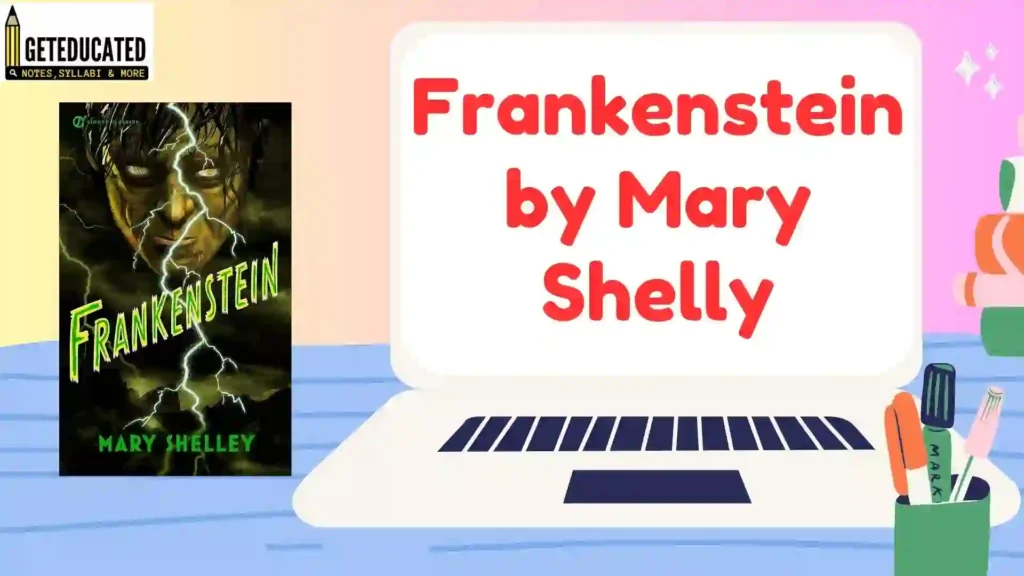
Main Theme and Plot in Mary Shelley’s Frankenstein : Mary Shelly’s Frankenstein has three separate plot lines that circulate through the novel. The first is the Robert Walton plot line that introduces and closes the novel. Walton exhibits all of the emotions that we would expect from a person hearing such a fantastic tale. This plot line is like a picture frame, in which the accompanying story line is the virtual frame that surrounds the novel’s main story. The second plot line, and most important, is the Victor Frankenstein plot line. This plot line takes up much of the novel’s volume. Perhaps the most overlooked plot line, in terms of importance, is the monster’s story. Mary Shelley gives the monster a voice, and the reader can sympathize with his pain and suffering at the hands of mankind. The portion of the tale dedicated to the story of the De Lacey family is part of the monster’s story.
Marry Shelley’s Frankenstein is a unique novel in the canon of English literature. The novel seeks to find the answers to questions that no doubt perplexed Mary Shelley and the readers of her time. Mary Shelley presents a unique character in Victor Frankenstein and his creation, the monster. It is as though there are two distinct halves to one character. Each half competes for attention from the other and for the chance to be the ruler of the other half. In the end, this competition reduces both men to ruins. Mary Shelley’s Keen Awareness Of The Technological Advancement Of Her Times.
Marry Shelley also is keenly aware of the concern that technology was advancing at a rate that dizzied the mind of early eighteenth century readers. Perhaps this novel is addressing that issue of advances created by men, but which fly in the face of “natural” elements and divine plans. Mary Shelley crafts her exquisite novel in a way to direct attention to the treatment of the poor and uneducated as a major theme throughout the book. She would have learned these precepts from her father William Godwin, a noted writer and philosopher. (Refer to the “Life and Background” section.) But the beginnings of the historical background go back much further than Shelley’ own time.
The Industrial Revolution also gave rise to a new social class in European society, the middle class. As more businesses moved from home- or cottage-based operations, factories became the next place where conflict would be waged between the working poor and their employers. New towns sprang up with a new set of problems for local governments. Few checks and balances existed for factory owners or governments. As a result, town life was forbidding and dangerous. The countryside yielded little relief from city life, as small farmers had to make a living on small plots of land, in contrast to large landowners. Usually, the old gentries had ruled the land for many years previous, and they controlled the larger portions of land, thus regulating its use. The poor enjoyed a better standard of living than previously, but the concerns of the poor and the gap between the rich and poor became more pronounced during this period.
Frankenstein is part of the Gothic movement in literature a form that was only just becoming popular in England at the time of its publication. The Gothic mode was a reaction against the humanistic, rationalist literature of The Age of Reason; one might say it was ushered in by the death of Keats, the English author with whom Romanticism is perhaps most closely associated. Frankenstein might be seen as a compromise between the Gothic approach and the Romantic one: it addresses serious philosophical subjects in a fantastical manner though it confronts recognizable human problems, it can hardly be said to take place in a “rational,” comprehensible, recognizable natural world. Some critics have suggested that this tension between Gothic and Romantic literary modes echoes the philosophical tension that existed between herself and her husband, the Romantic poet Percy Bysshe Shelley.
In a series of letters, Robert Walton, the captain of a ship bound for the North Pole, recounts to his sister back in England the progress of his dangerous mission. Successful early on, the mission is soon interrupted by seas full of impassable ice. Trapped. Walton encounters Victor Frankenstein, who has been travelling by dog-drawn sledge across the ice and is weakened by the cold. Walton takes him aboard ship. helps nurse him back to health, and hears the fantastic tale of the monster that Frankenstein created.
Suggested Reading :
Character Analysis of Victor Frankenstein
Victor first describes his early life in Geneva. At the end of a blissful childhood spent in the company of Elizabeth Lavenza (his cousin in the 1818 edition, his adopted sister in the 1831 edition) and friend Henry Clerval, Victor enters the University of Ingolstadt to stud, natural philosophy and chemistry. There, he is consumed by the desire to discover the secret of life and, after several years of research, becomes convinced that he has found it.
Armed with the knowledge he has long been seeking, Victor spends months feverishly fashioning a creature out of old body parts. One climactic night, in the secrecy of his apartment, he brings his creation to life. When he looks at the monstrosity that he has created, however, the sight horrifies him. After a fitful night of sleep, interrupted by the specter of the monster looming over him, he runs into the streets, eventually wandering in remorse. Victor runs into Henry, who has come to study at the university, and he takes his friend back to his apartment. Though the monster is gone, Victor falls into a feverish illness.
Sickened by his horrific deed, Victor prepares to return to Geneva, to his family, and to health. Just before departing Ingolstadt, however, he receives a letter from his father informing him that his youngest brother, William, has been murdered. Grief-stricken, Victor hurries home. While passing through the woods where William was strangled, he catches sight of the monster and becomes convinced that the monster is his brother’s murderer. Arriving in Geneva, Victor finds that Justine Moritz, a kind, gentle girl who had been adopted by the Frankenstein household, has been accused. She is tried, condemned, and executed, despite her assertions of innocence. Victor grows despondent, guilty with the knowledge that the monster he has created bears responsibility for the death of two innocent loved ones.
Hoping to ease his grief, Victor takes a vacation to the mountains. While he is alone one day, crossing an enormous glacier, the monster approaches him. The monster admits the murder of William but begs for understanding. Lonely, shunned, and forlorn, he says that he struck out at William in a desperate attempt to injure Victor, his cruel creator. The monster begs Victor to create a mate for him, a monster equally grotesque to serve as his sole companion.
Victor refuses at first, horrified by the prospect of creating a second monster. The monster is eloquent and persuasive, however, and he eventually convinces Victor. After returning to Geneva, Victor heads for England, accompanied by Henry, to gather information for the creation of a female monster. Leaving Henry in Scotland, he secludes himself on a desolate island in the Orkneys and works reluctantly at repeating his first success. One night, struck by doubts about the morality of his actions, Victor glances out the window to see the monster glaring in at him with a frightening grin. Horrified by the possible consequences of his work, Victor destroys his new creation. The monster, enraged, vows revenge, swearing that he will be with Victor on Victor’s wedding night.
Later that night, Victor takes a boat out onto a lake and dumps the remains of the second creature in the water. The wind picks up and prevents him from returning to the island. In the morning, he finds himself ashore near an unknown town. Upon landing, he is arrested and informed that he will be tried for a murder discovered the previous night. Victor denies any knowledge of the murder, but when shown the body, he is shocked to behold his friend Henry Clerval, with the mark of the monster’s fingers on his neck. Victor falls ill, raving and feverish, and is kept in prison until his recovery, after which he is acquitted of the crime.
Shortly after returning to Geneva with his father, Victor marries Elizabeth. He fears the monster’s warning and suspects that he will be murdered on his wedding night. To be cautious, he sends Elizabeth away to wait for him. While he awaits the monster, he hears Elizabeth scream and realizes that the monster had been hinting at killing his new bride, not himself. Victor returns home to his father, who dies of grief a short time later. Victor vows to devote the rest of his life to finding the monster and exacting his revenge, and he soon departs to begin his quest.
Victor tracks the monster ever northward into the ice. In a dogsled chase, Victor almost catches up with the monster, but the sea beneath them swells and the ice breaks, leaving an unbridgeable gap between them. At this point, Walton encounters Victor, and the narrative catches up to the time of Walton’s fourth letter to his sister.
Walton tells the remainder of the story in another series of letters to his sister. Victor, already ill when the two men meet, worsens and dies shortly thereafter. When Walton returns, several days later, to the room in which the body lies, he is startled to see the monster weeping over Victor. The monster tells Walton of his immense solitude, suffering, hatred, and remorse. He asserts that now that his creator has died, he too can end his suffering. The monster then departs for the northernmost ice to die.

[…] Theme and Plot of Frankenstein by Mary Shelley […]
[…] Theme and Plot of Frankenstein by Mary Shelley […]
[…] Theme and Plot of Frankenstein […]